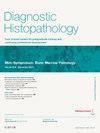Rosai-Dorfman disease: an unusual cutaneous nodule
引用次数: 0
Abstract
Rosai-Dorfman disease is an inflammatory non-neoplastic disease characterized by a histiocytic infiltrate in a polymorphous inflammatory background. It is typically presents in lymph nodes; cutaneous manifestation is uncommon. We present a case of cutaneous Rosai-Dorfman disease with classic cytomorphological and immunohistochemical features with a discussion around prognosis, follow-up and molecular testing.
罗赛-多夫曼病:一种不寻常的皮肤结节
罗赛-多夫曼病是一种炎症性非肿瘤疾病,其特征是多形性炎症背景下的组织细胞浸润。它通常出现在淋巴结,皮肤表现并不常见。我们介绍了一例具有典型细胞形态学和免疫组化特征的皮肤罗赛-多夫曼病,并围绕预后、随访和分子检测进行了讨论。
本文章由计算机程序翻译,如有差异,请以英文原文为准。
求助全文
约1分钟内获得全文
求助全文
来源期刊

Diagnostic Histopathology
Medicine-Pathology and Forensic Medicine
CiteScore
1.30
自引率
0.00%
发文量
64
期刊介绍:
This monthly review journal aims to provide the practising diagnostic pathologist and trainee pathologist with up-to-date reviews on histopathology and cytology and related technical advances. Each issue contains invited articles on a variety of topics from experts in the field and includes a mini-symposium exploring one subject in greater depth. Articles consist of system-based, disease-based reviews and advances in technology. They update the readers on day-to-day diagnostic work and keep them informed of important new developments. An additional feature is the short section devoted to hypotheses; these have been refereed. There is also a correspondence section.
 求助内容:
求助内容: 应助结果提醒方式:
应助结果提醒方式:


